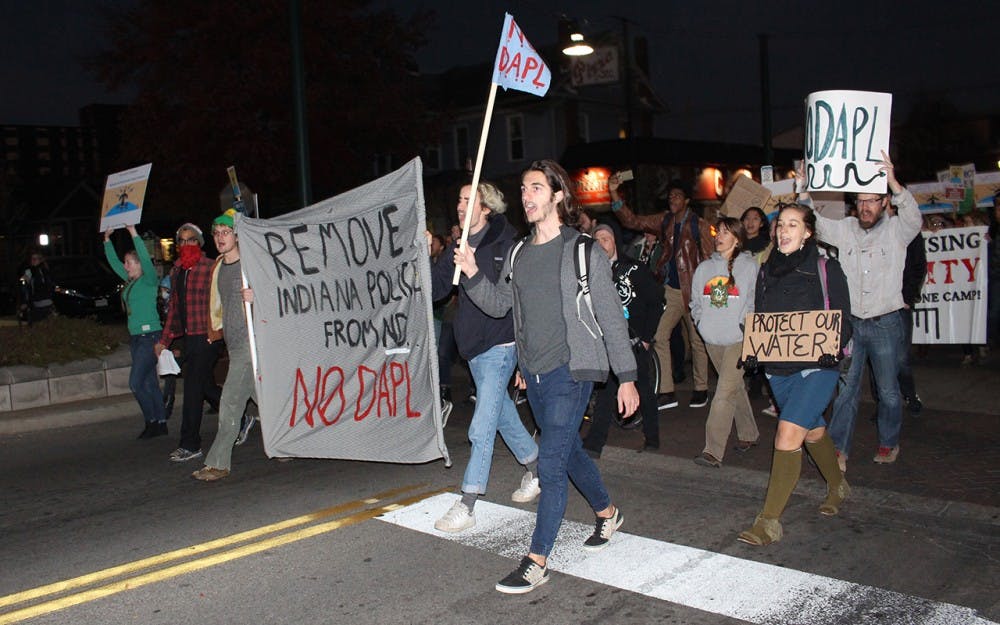Freezing fingers tapped on signs that read “We can’t drink oil” and “I stand with Standing Rock.” Heads bobbed as eyes shifted from the red brick ground around Sample Gates to Davina Two Bears’ solemn face.
Two Bears held a phone, which connected to a speaker. It played Frank Waln’s “7,” a song about a prophecy in which Native American youths protect their land.
“This is sound of a nation rising,” sounded from the speaker. “A generation with a vision. / We’re tired of our people dying.”
Students and community members gathered Tuesday evening for Students Against State Violence’s solidarity demonstration, which included a rally and a march through the streets of downtown Bloomington, against the Dakota Access Pipeline.
NoDAPL is a movement against the Dakota Access Pipeline, which Energy Transfer Partners is attempting to build on sacred Standing Rock Sioux land. The people who stand in opposition to the pipeline call themselves Water Protectors.
The rally and march were in direct response to the presence of 37 police officers from Indiana at Standing Rock, the official SASV statement said. The student organization said it was unacceptable Hoosier officers were there when the Water Protectors were strip-searched and harassed by guards, incarcerated in dog kennels and marked with numbers on their skin, much like in concentration camps.
Some in attendance at the rally were Native Americans, but many were not. Some had been to this sort of rally before, and some had been to Standing Rock, but many had not.
Two Bears, a member of the Arizona Navajo and an IU Ph.D. candidate in the Department of Anthropology, was the first speaker. Her son, Brady, who attends Bloomington High School South, watched from the crowd with a sign reading “#noDAPL” and “Water is our future.”
Two Bears asked where the Kickapoo, Piankashaw, Potawatomi and other tribes native to Indiana had gone. She answered her own question by saying the tribes had been on the land for thousands of years and pushed away by European settlers.
“We need to acknowledge this is how this country has operated for hundreds of years,” she said. “Why is this horrible, dirty oil being shoved down our throats?”
Some have denied the sacredness of the Standing Rock land because of the absence of physical materials on the ground, but Two Bears said their reasoning is flawed.
Native American sacred grounds are not like a stone church, she said. They are rivers and mountains and features of the earth.
Two Bears said the controversy surrounding the pipeline has finally opened the world’s eyes to the oppression of native peoples.
“Native people are still around,” Two Bears said. “We are not extinct.”
The crowd erupted in applause.
“First and foremost, this is about sovereignty,” said Kelly Tudor, the Indiana spokesperson for the American Indian Movement. “Anybody that wants to go out there needs to listen to the leadership of the Standing Rock Sioux tribe.”
Tudor has been to Standing Rock twice with her children and said some non-native people there have misinterpreted the point of the movement as climate change.
It is about the environment and the earth, Tudor said. Even more so it’s about the rights of sovereign native nations and the repeatedly broken treaties that are supposed to guarantee those rights.
Those were the rights Collins LLC residents Rachel Doehla and Maggie Gates had gone to support during fall break after they learned of the Standing Rock Water Protectors at the Hoosiers’ Climate March just a few days prior.
Their goal was to learn more about the threat the pipeline poses and to meet the Native American people who are dealing with it, they said. Now they said they hope to help educate others.
Gates spoke about the disproportionate number of people of color subjected to poisoned resources, like those in Flint, Michigan, and east Chicago.
“That is not a coincidence,” Gates said. “Our negative acts affect those without a voice first.”
The crowd erupted again.
Finally, Ana Stahlman, a member of the Bloomington community and the New York Tuscarora, read a poem.
At its completion, the crowd began moving down Kirkwood Avenue, silent in their first steps. From the silence sprang a chant.
“Mni Wiconi,” they said. “Water is life.”




